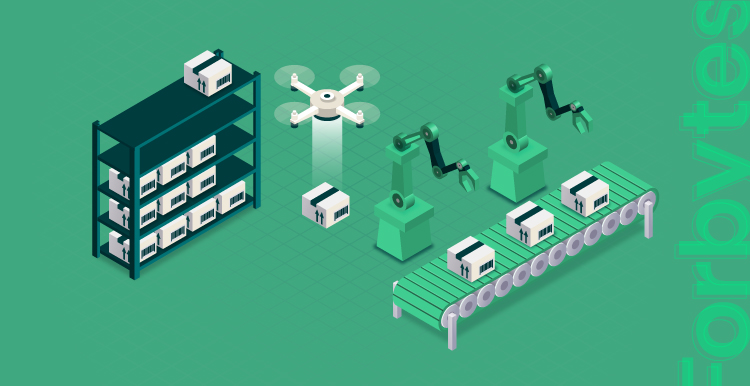In 2020, global retail eCommerce sales reached $4.28 trillion. In 2024, revenues are anticipated to increase to $6.38 trillion. With these rising figures, the ecommerce sphere requires businesses to devote a lot of time to fulfilling repetitive tasks. For example, managing orders and payments around the clock, managing inventory tasks, scheduling sales campaigns, and much more. Thus, in the 2020s, the driving factors of your ROI are the automation of digital commerce efforts and the rising demand for automated ecommerce.
What is going on in the ecommerce world today? The behavioral patterns of consumers have changed drastically due to the impact of the pandemic. The latter also continues to fuel the shift in digital selling. The adoption of digitalization, artificial intelligence, and automation has accelerated, enabling businesses to reshape their workloads. According to the McKinsey global survey of 800 executives, 85% of companies have accelerated digitization, and 67% of companies have accelerated automation and artificial intelligence during the COVID-19 pandemic.
Like other businesses, you may want to keep each workflow under control, engage more customers, and boost your sales funnels. Automation is actually your weapon to achieve all this. Read further to unleash the opportunities for business performance that are offered by digital automation.
What Is eCommerce Automation and How Can It Benefit Your Business?
eCommerce automation allows businesses to simplify and streamline their manual workflows with the help of automation tools. When companies scale up and grow, their existing systems need to scale as well to be able to run complex tasks. Otherwise, these systems will be inefficient, which will result in hiring more staff and dealing with time-consuming workarounds. With automated ecommerce, your employees can be focused on business-critical and strategic tasks such as customer interactions, predictions, decision-making, etc.

Unfortunately, many companies still tend to hire more human resources instead of adopting automation tools that streamline and simplify activities and improve customer experiences. Let’s take the example of inventory management. You can automatically trigger a message to your marketing team when a product is out of stock to pause product publication on your website. Or you can tag customers based on their specific attributes, send personalized thank you messages, and offer discounts — all this with the help of automation tools.
Let’s outline the main benefits your business can gain from eCommerce automation:
- Time efficiency and better work engagement. With automation, your teams do not have to spend time on mundane tasks. By streamlining your business operations, you give your employees extra time for more business-oriented tasks. Instead of wasting their effort, the teams can focus on enhancing customer experiences and ensuring better deals with suppliers. Besides, automation software can automatically schedule sales promotions, send out customer emails, segment your customer profile data, and generate invoices. All this will optimize employee work and shift their focus to more important processes.
- Improvement of customer satisfaction. With plenty of customers, you might want to automate activities related to their reach out and client assistance. By automating sales and marketing tasks, you can provide much more qualitative service and improve customer experience. eCommerce automation tools will instantly track their journeys and facilitate online shopping engagement.
- Solid interaction with suppliers. Your interaction with suppliers can be fast and seamless with effective automation processes. For example, if you are out of stock or your inventory is below a certain level, the software can generate triggers for your suppliers and automatically notify them of the issue. Your communication with suppliers will not be lost or delayed, leading to profitable and long-term relationships.
- Increasement of conversion rates. Automation tools can be an aid to your customers when upselling or cross-selling related products. For example, in the section “You might also like” or “Related products”, a tool can automatically generate offers to customers and increase your overall revenue. Moreover, with automation, your marketing team can upgrade their follow-up campaigns by collecting real-time data from different channels.
How to Automate Your Ecommerce Business
Inventory and Order Management Automation
- Automated abandoned cart emails. Cart abandonment is caused by different reasons, from lost internet connection to lack of available funds. When such an issue occurs, there is a high possibility that a buyer will leave your platform without finalizing a purchase. This explains why the average cart abandonment rate is almost 70%. To trigger cart recovery, integrate your eCommerce software with the email provider that can send automated scheduled reminder emails to customers who abandoned their carts. Check out the following solutions to reduce shopping cart abandonment if you need more info.
- Real-time monitoring of your inventory. With an automation tool, a purchase order will be automatically generated and forwarded to a relevant warehouse or supplier. In this way, your stock levels will be permanently monitored and adjusted accordingly. Automation tools enable low-stock or out-of-stock notifications that are automatically triggered based on the thresholds. As a result, your inventory levels will be reordered and replenished in time.
- Automated shipping label printing. Labels can be generated automatically once an order is placed. By integrating your online store with shipping label printing providers (PluginHive, Webshipper, ShippingEasy), your labels will be printed automatically in bulk according to order attributes and preferences. By setting up custom automation with the workflow, you streamline your shipping. This, in turn, enables you to generate and send tracking numbers and effortlessly mark your orders as completed.

Marketing Automation
There is no need to perform tedious marketing-related tasks manually. Sending emails, nurturing leads, email segmentation, social media posting, etc., can be done with marketing automation tools. They optimize workflows tremendously and give the following benefits:
- Email marketing automation. In 2021, 76% of marketers stated that users engaged with email more over the past year. Message personalization, subscriber segmentation, and email automation campaigns are among the best tactics of a solid marketing strategy. Email marketing automation may encompass the following:
1) Abandoned cart recovery emails (mentioned above).
2) Customer loyalty emails (rewards or discounts for the customers’ loyalty). With automated customer loyalty programs, customers get loyalty points automatically along with personalized offers.
3) Email segmentation. Segmentation by criteria can make your customers more interested in purchasing your products. Click rates of segmented email campaigns are 54.79% higher than non-segmented campaigns as per the MailChimp survey. Still, it may seem a daunting task to segment all your leads manually. With email marketing software like Constant Contact, Infusion Soft, Drip, or HubSpot, you can implement quick and easy segmentation strategies to deliver a personalized experience to your customers.
4) Cross-sell and up-sell. It’s always a good idea to suggest a related product to your buyers based on the product they have already bought. But when it is done automatically and with an extra coupon or free shipping offering for the next purchase, your AOV with customers increases. Also, you become more tactical in your sales strategies. Omnisend is an example of a company that offers its clients cross-selling opportunities.
- Automated social media and content posting. In today’s marketplace, social media is not only a channel for building a brand presence but an integral part of the omnichannel approach. Indeed, B2B users tend to seamlessly and consistently move through the channels, which means they can be interested in the product on one channel and purchase it on another. According to a survey among eCommerce decision-makers in North America and Europe, 30% of businesses already sell via social media platforms. Another 33% of responders are evaluating this strategy. Therefore, it is important that each social channel is solid enough to engage your audience. There are a lot of automation tools that can streamline your content generation processes and automatically schedule social posts: SproutSocial, Buzzsumo, CoSchedule, Hootsuite.
Customer Experience Automation
- Chatbots. According to Salesforce, 23% of customer service companies use AI-powered chatbots. Statista states that the global chatbot market revenue is growing substantially ($83 million in 2021, which is expected to grow up to $239 in 2025). Leveraging a chatbot platform can resolve a set of issues like har navigation, difficulties in finding answers to simple questions, and non-seamless user experience. AI chatbot tools like Botsify or Flow XO can help predict customers’ needs based on previous experiences and apply upselling approaches. They can be used to respond to social media posts or offer assistance to your website visitors. Using chatbots leads to customer service optimization as the clients and leads get assistance without time constraints.
- Customers’ segmentation based on their buying behavior. To better understand customer behaviors, you might want to classify them based on their characteristics. Using the automated tools, you can segment your customers by different criteria (demographics, gender, age, order value, product preferences, satisfaction scores, subscriptions, etc.). The better you segment your customer base, the higher your chances to drive maximum ROI.
- Rewards for the most engaged customers. To reward customer loyalty, you can develop a reward program and allow your customers to feel special and valued. However, keeping track of the clients who get gifts or promos (for example, they celebrate their birthdays) may turn out to be overwhelming. In this case, you can apply event-triggered emails.
Business Management Automation
- Simplified workflows with integration tools. With external tools like Zapier, Microsoft Flow, or Automate.io, you can synchronize data between multiple applications and automate workflows.
- Internal platforms. To sync your team efforts and optimize workflows, you can use various business process automation tools: Jira, Slack, Trello, etc. These tools help structure processes, manage vendor payments, prioritize and track tasks, and generally facilitate projects.
How to Integrate Workflow Automation into Your eCommerce Business
eCommerce business automation allows you to streamline your workflows and speed up processes at the click of a button. You do not need any hardware or programming. According to the McKinsey report, in 2020, more companies tended to automate their business processes compared to 2018.

We outlined four steps for integrating an automation solution:
- Identify routine tasks. According to the UiPath survey among global office workers, 67% of respondents waste approximately 5 hours per week on repetitive and time-consuming tasks that they think can be automated. Therefore, you should start by analyzing your current operation and workload to identify the bottlenecks that affect employees’ productivity and overall business performance.
- Determine the areas to be automated. Global workers surveyed stated that emails (60%), dataset creation (59%), and scheduling calls/meetings (57%) are the top 3 areas they would like to automate. For instance, to optimize efforts on email campaigns, think about automated segmentation.
- Find an automation solution. Whether you want to streamline your accounting processes, inventory and order management, or marketing efforts, weigh all pros and cons of the solution you are going to use. Choose the one that best meets your goals and needs.
- Train your employees. As per the above-mentioned survey, 44% of workers were trained in applying automation in their work. 91% believed their job performance enhanced. Once you decide to implement automation tools, train your staff to utilize them and take much out of them.
- Measure and track performance. To analyze the efficiency and benefits of your automation solution, keep track of all the processes backed by tools and evaluate the performance of each employee. If there is no obvious acceleration in your business performance, then consider different areas that can be automated and streamlined or add other functions to your software.
Summary
The choice of an eCommerce automation tool depends on your business needs. To define what areas of your business can fall into automated ecommerce, you need to find the pain points and identify your routine tasks. Maybe, interaction with your suppliers needs to be increased to deliver fast solutions to your customers smoothly and seamlessly. Or perhaps, you need to ease your customer service efforts by applying AI-powered chatbots. Anyway, with automation software, you can doubtlessly boost your eCommerce sales.
Let us know if you are looking for an automation tool – our experts help businesses develop B2B and B2C eCommerce solutions for any industry.

Our Engineers
Can Help
Are you ready to discover all benefits of running a business in the digital era?

Our Engineers
Can Help
Are you ready to discover all benefits of running a business in the digital era?







